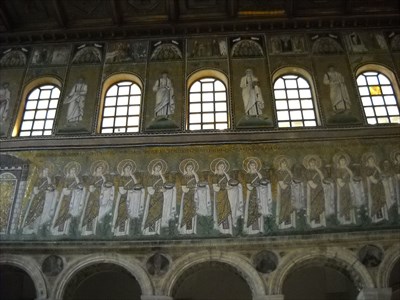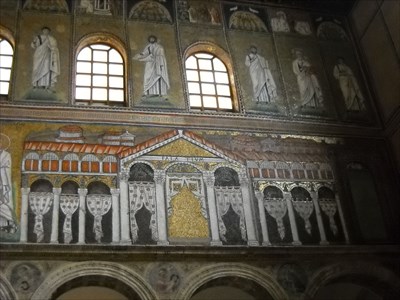
 The Basilica of Sant'Apollinare Nuovo, built by Theoderic (493-526) next to his palace, was originally used as a Palatine Church of Arian religion.
The Basilica of Sant'Apollinare Nuovo, built by Theoderic (493-526) next to his palace, was originally used as a Palatine Church of Arian religion.
Like all the churches of Ravenna from the imperial period (until 476), Ostrogothic (until 540) and Justinian (from 540), the Basilica Sant'Apollinare Nuovo is adorned with marvelous polychrome mosaics.
These mosaics do not all belong to the same period: some date back to Theodoric, and others to the redecoration desired by Bishop Agnello, during the conversion of the building to Catholic worship.
The walls of the central nave have three distinct areas of mosaic decoration.
Mosaics of the Upper Register: The highest register is decorated with panels alternating patterns with two doves and scenes from the New Testament (above the windows), showing the Life of Christ. These are treated in detail, while their situation does not make it easy to read. Some of these scenes give an idea of the evolution of mosaic art in the time of Theodoric.
Mosaics of the median register: The median register alternates with the windows which frame solid figures of saints and prophets with long shaded and delicately draped robes. They appear clearly in perspective, despite the indefinite gold background on which they stand out.
Mosaics of the lower register: The lower register of mosaics is the most important, but also the most altered. The right banner (looking towards the apse) opens with a figure of the famous Palace of Theodoric, identifiable by the Latin inscription PALATIVM (palace) readable at the bottom of the pediment.
The apse, destroyed by an earthquake, has been rebuilt, and is thus completely deprived of mosaics that adorned it, probably in the style of those that can still be admired in the Basilica of Saint Apollinaire in Class.
Sources : The Church


 La Basilique Saint-Apollinaire-le-Neuf, que Théodoric (493-526) fit construire à côté de son Palais, était à l’origine une église palatine, de culte arien.
La Basilique Saint-Apollinaire-le-Neuf, que Théodoric (493-526) fit construire à côté de son Palais, était à l’origine une église palatine, de culte arien.
Comme toutes les églises de Ravenne de la période impériale (jusqu'en 476), ostrogothique (jusqu'en 540) et justinienne (à partir de 540), la basilique Sant'Apollinare Nuovo est ornée de merveilleuses mosaïques polychromes.
Ces mosaïques n'appartiennent pas toutes à la même époque : les unes remontent à Théodoric, et d'autres à la redécoration voulue par l'évêque Agnello, lors de la conversion de l'édifice au culte catholique.
Les murs de la nef centrale présentent trois zones bien distinctes de décoration en mosaïques.
Mosaïques du registre supérieur: Le registre le plus élevé est décoré de panneaux alternant des motifs à deux colombes et des scènes du Nouveau Testament (au-dessus des fenêtres), montrant la Vie du Christ. Celles-ci sont traitées en détail, alors que leur situation n'en rend pas la lecture aisée. Certaines de ces scènes donnent une idée de l'évolution de l'art de la mosaïque au temps de Théodoric.
Mosaïques du registre médian: Le registre médian alterne avec les fenêtres qui encadrent de solides figures de saints et prophètes aux longues robes ombragées et délicatement drapées. Ils apparaissent nettement en perspective, malgré le fond d'or indéfini sur lequel ils se détachent.
Mosaïques du registre inférieur: Le registre inférieur des mosaïques est le plus important, mais aussi le plus altéré. Le bandeau droit (en regardant vers l'abside) s'ouvre par une figure du fameux palais de Théodoric, identifiable par l'inscription latine PALATIVM (palais) lisible au bas du fronton.
L'abside, détruite par un séisme, a été reconstruite, et se trouve donc entièrement privée des mosaïques qui l'ornaient, sans doute dans le style de celles que l'on peut encore admirer dans la basilique Saint-Apollinaire in Classe.
Sources : L’Eglise

<
p>

 La Basilica di Sant'Apollinare Nuovo, fatta costruire da Teoderico (493-526) accanto al suo palazzo, fu in origine adibita a Chiesa palatina, di culto ariano.
La Basilica di Sant'Apollinare Nuovo, fatta costruire da Teoderico (493-526) accanto al suo palazzo, fu in origine adibita a Chiesa palatina, di culto ariano.
Come tutte le chiese Ravenna del periodo imperiale (fino al 476), ostrogoto (fino al 540) e Giustiniano (da 540), la Basilica di Sant'Apollinare Nuovo è decorata con splendidi mosaici policromi.
Questi mosaici non appartengono allo stesso periodo: alcuni risalgono a Teodorico e altri alla redecorazione voluta dal vescovo Agnello, durante la conversione dell'edificio al culto cattolico.
Le pareti della navata centrale hanno tre aree distinte di decorazione mosaico.
Mosaici del registro superiore: Il registro più alto è decorato con pannelli alternati a due colombe e scene del Nuovo Testamento (sopra le finestre), mostrando la Vita di Cristo. Questi vengono trattati in dettaglio, mentre la loro situazione non rende facile la lettura. Alcune di queste scene danno un'idea dell'evoluzione dell'arte del mosaico nel tempo di Teodorico.
Mosaici del registro mediano: Il registro mediano si alterna con le finestre che inquadrano figure solide di santi e profeti con lunghe ombreggiate e delicatamente drappeggiate abiti. Essi appaiono chiaramente in prospettiva, nonostante l'oro indefinito d'oro su cui si distinguono.
Mosaici del registro inferiore: il registro inferiore dei mosaici è il più importante, ma anche il più alterato. Il pannello di destra (guardando verso l'abside) si apre con una figura del famoso palazzo di Teodorico, identificabili dalla scritta latina PALATIVM (palazzo) leggere in fondo del frontone.
L'abside, distrutta da un terremoto, è stato ricostruito, ed è quindi mosaici completamente privati che adornavano, probabilmente nello stile di quelli che si possono ancora ammirare nella Basilica S. Apollinare in Classe.
Sources : La Chiesa